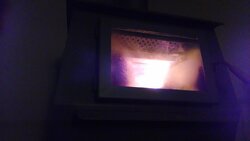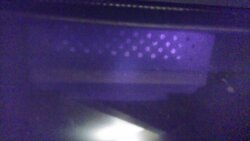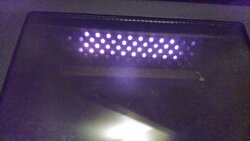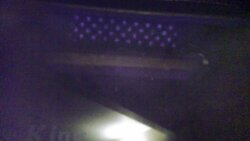There are a great deal of personal observations with regard to combustor activity. There are two facts we know about combustors and their efficacy. First, they need not be glowing to be working and second, a glowing combustor is "glowing" because of a rich fuel environment. Many consumers report glowing more often than others, which is completely understandable given the varying nature of the way stoves are operated and the fuel that is burned.
Moist or wet wood will have water boiled out of the wood (steam) and cool both metal surfaces of the stove (think heat exchanger) and the combustor itself.
When the air fuel ratio is just right (meaning very rich) combustors will glow slightly, partially. or completely. Some times they glow so brightly you can see them doing so across the room.
We know from 33 years of combustor research, residence time also plays a role in combustor glowing. This again does not suggest working or not working, but glowing. Typically, when the thermostat on our stoves are reduced down in burn rate (lower) the gases flowing through the combustor are slowed down, increasing residence time...how long it takes for the gases to pass through the combustor.
I have attached some images to help relate this to real world use. The stove is my own; the images were taken yesterday on Christmas Day. I burn NIEL's and had a very hot fire going. Image one shows no glowing whatsoever, yet the combustor was 915 degrees (thermocouple reading taken on exit temps)
The second image is after 10-15 minutes of having the thermostat moved from a high burn rate to a medium burn rate. After 15 minutes there is slight glowing taking place. Combustor temps increase to 1090.
The third image is only 5 minutes later and the combustor is glowing quite brightly. The combustor is now 1175, yet the burn rate is now at medium low.
The fourth and final image is 10 minutes later after adding two half rounds of western larch, 19% m.c. Two things are true, opening the door cooled the combustor and second, moisture in fuel is being released. As you can see, there is little glowing taking place.
There is also a slight amount of opacity eminating from the chimney, which disappears in 14 minutes. The combustor hovers around 875-945 degrees during this time.
So can you stall a combustor, you bet! It can appear you have sufficient draft when burning on higher burn rates, but if you reduce the burn rate below a unique level for the individual application, you can not have sufficient draft to keep the stove operating correctly. DRAFT IS NOT CONSTANT.
So while a catalytic equipped stove can operate just fine and have a strong amount of draft as measured in w.c. inches, you can operate a stove at too low a burn rate to keep enough hot gases in the flue and therefore keep the stove drafting and the end result is the combustor drops below 550 degrees and is no longer active.
We belong to a collective group of catalyst equipped stove companies and these observations are in line with observations made by these companies for their products.
Lastly, I hope you all had a wonderful Christmas and now go enjoy the New Year!
Chris
Moist or wet wood will have water boiled out of the wood (steam) and cool both metal surfaces of the stove (think heat exchanger) and the combustor itself.
When the air fuel ratio is just right (meaning very rich) combustors will glow slightly, partially. or completely. Some times they glow so brightly you can see them doing so across the room.
We know from 33 years of combustor research, residence time also plays a role in combustor glowing. This again does not suggest working or not working, but glowing. Typically, when the thermostat on our stoves are reduced down in burn rate (lower) the gases flowing through the combustor are slowed down, increasing residence time...how long it takes for the gases to pass through the combustor.
I have attached some images to help relate this to real world use. The stove is my own; the images were taken yesterday on Christmas Day. I burn NIEL's and had a very hot fire going. Image one shows no glowing whatsoever, yet the combustor was 915 degrees (thermocouple reading taken on exit temps)
The second image is after 10-15 minutes of having the thermostat moved from a high burn rate to a medium burn rate. After 15 minutes there is slight glowing taking place. Combustor temps increase to 1090.
The third image is only 5 minutes later and the combustor is glowing quite brightly. The combustor is now 1175, yet the burn rate is now at medium low.
The fourth and final image is 10 minutes later after adding two half rounds of western larch, 19% m.c. Two things are true, opening the door cooled the combustor and second, moisture in fuel is being released. As you can see, there is little glowing taking place.
There is also a slight amount of opacity eminating from the chimney, which disappears in 14 minutes. The combustor hovers around 875-945 degrees during this time.
So can you stall a combustor, you bet! It can appear you have sufficient draft when burning on higher burn rates, but if you reduce the burn rate below a unique level for the individual application, you can not have sufficient draft to keep the stove operating correctly. DRAFT IS NOT CONSTANT.
So while a catalytic equipped stove can operate just fine and have a strong amount of draft as measured in w.c. inches, you can operate a stove at too low a burn rate to keep enough hot gases in the flue and therefore keep the stove drafting and the end result is the combustor drops below 550 degrees and is no longer active.
We belong to a collective group of catalyst equipped stove companies and these observations are in line with observations made by these companies for their products.
Lastly, I hope you all had a wonderful Christmas and now go enjoy the New Year!
Chris







